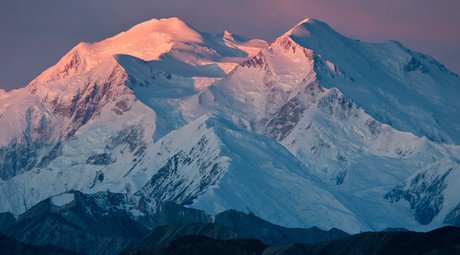Alaska governor wants more oil drilling... to pay for climate change costs

Faced with the growing cost of climate change, authorities in Alaska are advocating more oil exploration. Plummeting oil prices have put a strain on Alaska’s coffers, as the state gets most of its revenues from petroleum taxes and fees.
“We are in a significant fiscal challenge. We have villages that are washing away because of changes in the climate,” Governor Bill Walker, an independent, told the BBC in an interview Monday. To illustrate the point, he brought up a village in northwestern Alaska, threatened by rising water levels and soil erosion.
"I don't see anyone putting together contribution funds to help move Kivalina,” Walker said. “That is our obligation, we stand by that ‒ we need to figure out how to do that. But those are very expensive. We have about 12 villages in that situation.”
Alaska's "solution" to #climate change? Drill for more #oil - no, seriously: http://t.co/fEbo8vJEal#StopFundingFossils@AkGovBillWalker
— Alex Doukas (@adoukas) October 13, 2015Kivalina is located on a barrier island at the entrance to the lagoon where the Kivalina River meets the Chukchi Sea. Of its almost 400 inhabitants, the vast majority are indigenous Alaskans. The Army Corps of Engineers estimated the cost of relocating the village at anywhere between $95 and $125 million, while the Government Accountability Office (GAO) estimate runs as high as $400 million. Alaska is requesting $162.4 million in relief for Kivalina and other villages vulnerable to climate change.
To raise additional revenue, Walker is advocating an increase in oil exploration, eyeing the Arctic National Wildlife Refuge (ANWR), a vast nature preserve in the northeast Alaska along the Canadian border. Drilling “in a responsible way, as we have in the past” could help relieve the state’s financial strain, the governor told the BBC, adding that it could be done using the “Norway model” of empowering the local communities.
“This isn’t something we can put off for 10-20 years,” Walker said. “We have to begin this process now ‒ it’s an absolute urgency for Alaska.”
Alaska has no income or sales tax, so it relies on petroleum revenues to fill up the state’s treasury. With the price of oil plummeting and current facilities operating at a quarter of their capacity, the state is facing significant budget shortfalls: The total 2015 revenue is estimated at only $9.6 billion, down from $17.2 billion in 2014. Almost a third of the 2014 income, $5.7 billion, came from petroleum-related sources.
READ MORE: On Alaska visit, Obama pushes Arctic agenda
Oil exploration in the ANWR is opposed by Native Alaskans, environmental activists and the Obama administration.
The Gwich'in community, native to northeast Alaska, relies on the Porcupine caribou for food and other necessities. Research by the Alaska Department of Fish and Game indicates that drilling in the ANWR might endanger the caribou population.
#Shell halts #Alaska offshore #drilling project over disappointing oil deposit results http://t.co/9neQ2aj9MCpic.twitter.com/0qiw8AUWZs
— RT America (@RT_America) September 28, 2015
Earlier this year, the Obama administration approved a proposal by Royal Dutch Shell to drill for oil in the Chukchi Sea. While shrugging off the protests by environmentalists, Shell announced last month it would postpone the exploration, declaring it unprofitable at current price levels.
Alaska is the largest and the most sparsely populated US state. A former Russian colony, it was sold to the US in 1867, at a price of 2 cents per acre, or $7.2 million (approximately $121 million today). It was not until the discovery of gold in the 1890s that the US realized the true value of the territory.















